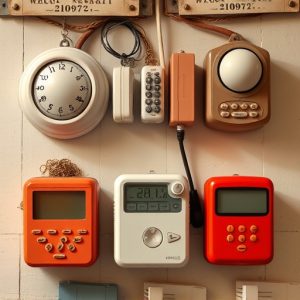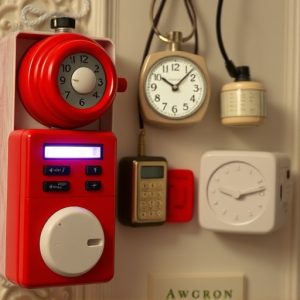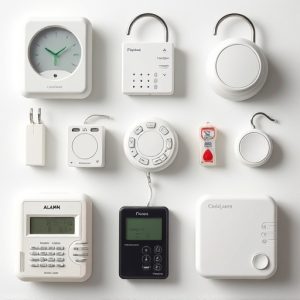Personal Alarms with Phone Alerts: Maximizing Safety & Peace of Mind
Body-worn panic alarms, like those with phone alert features, offer immediate emergency assistance t…….
Body-worn panic alarms, like those with phone alert features, offer immediate emergency assistance through loud alerts that summon help. Activated alarms send location data to monitoring centers or contacts via a smartphone app. Ideal for isolated areas and vulnerable individuals, these devices provide peace of mind and two-way communication for swift responses. When choosing a body-worn alarm, consider intuitive design, long battery life, water resistance, and compatibility with apps enabling real-time tracking (e.g., Personal Alarm With Phone Alert). However, the integration of this technology raises privacy concerns, necessitating explicit user consent, robust encryption, and compliance with data protection laws.
“In today’s ever-changing landscape, personal safety is paramount. This is where body-worn panic alarms with monitoring systems step in as invaluable tools for self-defense and emergency communication. Understanding these devices and their capabilities is crucial for individuals seeking peace of mind.
From the moment you activate a personal alarm with phone alert, a network of support springs into action. This article delves into the intricacies of body-worn panic alarms, exploring how they work, their benefits, and the considerations when choosing the right system, all while addressing legal and privacy concerns.”
- Understanding Body-Worn Panic Alarms: A Lifesaving Tool
- How Personal Alarms with Phone Alerts Work
- Benefits of Real-Time Monitoring for Safety
- Choosing the Right Body-Worn Alarm System
- Legal Considerations and Privacy Concerns
Understanding Body-Worn Panic Alarms: A Lifesaving Tool
Body-worn panic alarms, also known as personal alarm with phone alert, are compact, wearable devices designed to provide immediate assistance during emergencies. These innovative tools offer a sense of security by allowing users to quickly trigger an alert, often in the form of a loud siren or distinctive beep, that can attract attention and summon help. When activated, these alarms typically send a signal to emergency contacts or monitoring centers, providing real-time location data and alerting first responders to the user’s distress.
This technology is especially valuable for individuals who may be at risk in isolated areas, such as those with medical conditions, seniors living alone, or outdoor enthusiasts venturing into remote locations. By wearing a panic alarm, users can gain peace of mind knowing that help is just a press of a button away. Moreover, the integration with smartphones ensures that support networks remain informed and connected, enabling swift responses during critical situations.
How Personal Alarms with Phone Alerts Work
Personal alarms with phone alerts are innovative safety devices designed to provide individuals with a sense of security and rapid response in case of emergencies. These compact, wearable devices typically include a small alarm button that, when activated, triggers a series of actions. Upon pressing the alert button, a signal is sent to a monitoring center or directly to designated emergency contacts via a mobile app. This instant notification allows friends, family, or emergency services to receive vital information about the wearer’s location and the nature of the distress.
The app associated with these personal alarms enables users to set up alerts and monitor the device’s status in real-time. It provides peace of mind by allowing wearers to share their location and travel plans with trusted individuals, who can then receive automatic check-in updates. This two-way communication ensures that help can be dispatched promptly if needed, making personal alarms with phone alerts a valuable tool for solo travelers, outdoor enthusiasts, or anyone prioritizing personal safety.
Benefits of Real-Time Monitoring for Safety
Real-time monitoring through features like a personal alarm with phone alert offers unparalleled safety advantages. This technology allows for immediate response to distress signals, empowering individuals to quickly summon help in case of emergencies. Whether at home, outdoors, or in remote areas, the ability to trigger an alert and have it instantly conveyed to emergency contacts can significantly enhance personal security.
Such monitoring systems provide peace of mind by ensuring that aid can reach the wearer swiftly. This is especially crucial for vulnerable individuals, such as the elderly or those with health conditions, who might need assistance without being able to vocalize their needs. The integration of personal alarm with phone alert technologies into safety protocols thus represents a substantial step forward in promoting safety and well-being.
Choosing the Right Body-Worn Alarm System
Choosing the right body-worn alarm system is a critical step in ensuring personal safety, especially for those who frequently find themselves in isolated or potentially dangerous situations. When selecting a device, consider its ease of use and reliability; a simple, straightforward design with clear buttons and intuitive functionality will ensure users can activate the alarm quickly when needed. Additionally, look for systems that offer phone alert capabilities, enabling immediate communication with emergency contacts via a dedicated app.
Key features to seek include long-lasting battery life, water resistance, and discreet packaging to prevent deterring potential attackers. It’s also beneficial to opt for devices compatible with existing smartphone apps for remote monitoring, allowing friends or family members to track your location in real time and respond swiftly if necessary. This technology empowers individuals to maintain a sense of security while offering peace of mind.
Legal Considerations and Privacy Concerns
The implementation of body-worn panic alarms with monitoring capabilities raises several legal considerations and privacy concerns, especially in public spaces. In many jurisdictions, individuals have a reasonable expectation of privacy, and any surveillance or tracking must adhere to strict guidelines. One key aspect is obtaining consent from users, particularly when it comes to data collection and sharing. With personal alarms that send alerts to mobile phones, there’s an inherent need to access location data, which requires explicit permission from the user.
Privacy laws vary across regions, but many emphasize the right to be informed about data usage and storage. Using body-worn alarms for monitoring should comply with these regulations to protect users’ privacy. Additionally, ensuring secure data transmission and storage is vital to prevent unauthorized access or misuse of personal information. This includes implementing robust encryption methods and access controls to safeguard sensitive data, such as location details associated with panic alerts.
Body-worn panic alarms with real-time monitoring offer a powerful personal safety solution, especially in situations where quick response is crucial. By integrating these devices with phone alerts, individuals can ensure immediate assistance during emergencies. The benefits extend to various scenarios, from outdoor activities and travel to daily commutes and personal security at home. When choosing a system, consider factors like reliability, user-friendliness, and privacy measures aligned with legal considerations. Investing in a quality body-worn panic alarm with phone alert capabilities can provide peace of mind and enhanced safety for individuals facing unexpected situations.


